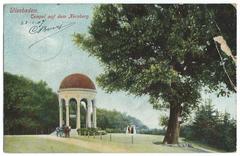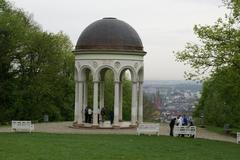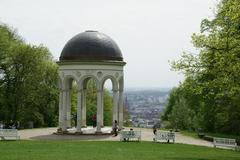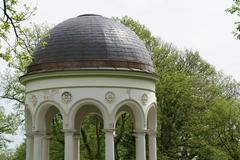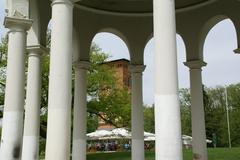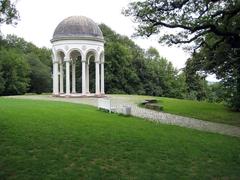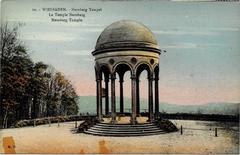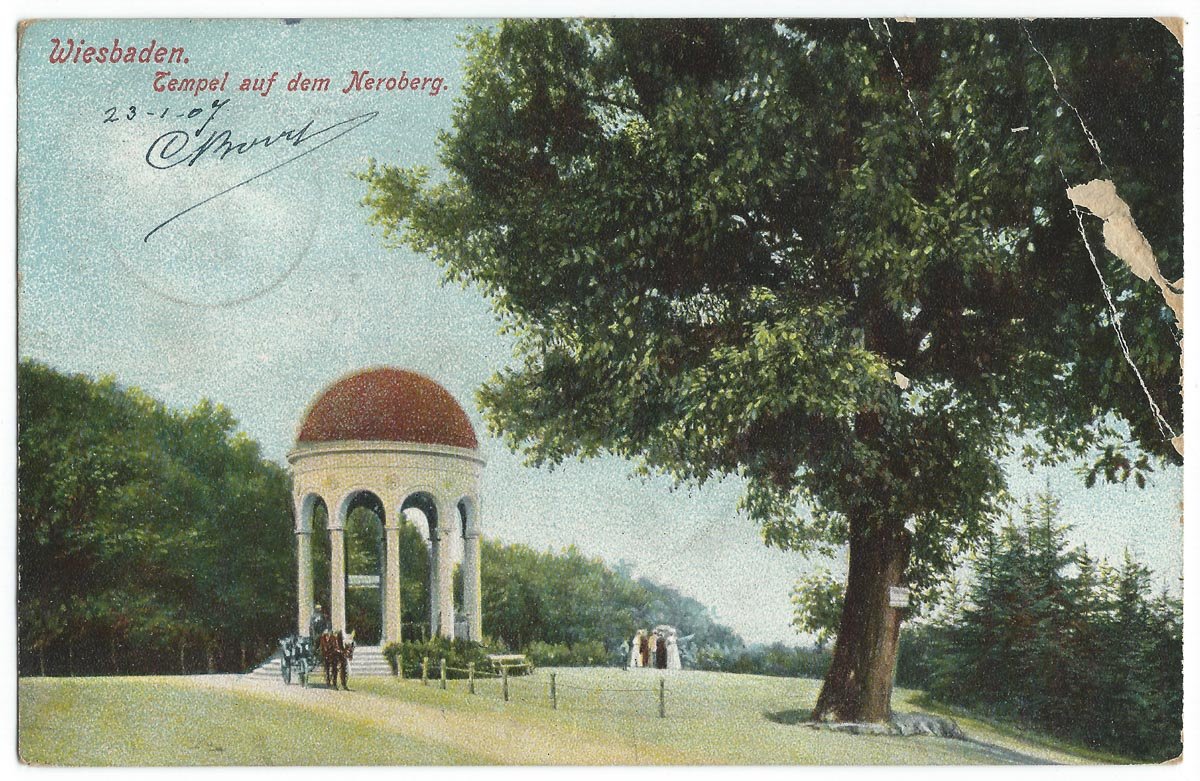
Neroberg Temple Wiesbaden: Visiting Hours, Tickets, and Historical Significance
Date: 14/06/2025
Introduction
Perched atop Wiesbaden’s Neroberg hill at 245 meters above sea level, the Neroberg Temple (Monopteros) is an open-air classical pavilion that perfectly embodies the city’s spa culture, architectural elegance, and panoramic charm. Constructed between 1851 and 1853, the temple was never intended as a religious structure but as an ornamental garden feature reflecting 19th-century romantic ideals. Today, it stands at the heart of a vibrant recreational area, offering breathtaking city and Rhine Valley views, and serving as a starting point for exploring Wiesbaden’s historical and cultural attractions.
Easily accessed via the historic Nerobergbahn funicular—one of the world’s few remaining water-ballast railways—or by well-marked hiking trails, Neroberg Temple and its surroundings invite visitors of all ages to experience a unique blend of history, leisure, and nature. With its proximity to the Russian Orthodox Church, Opelbad swimming pool, Kletterwald climbing forest, and a packed event calendar, Neroberg is a must-see destination for locals and tourists alike.
This guide provides detailed information on visiting hours, ticketing, accessibility, historical context, nearby attractions, and insider travel tips to help you plan your Neroberg adventure. For the latest updates and practical details, consult the official Wiesbaden tourism website, WildTrips, and The Crazy Tourist.
Table of Contents
- Introduction
- Historical Background
- Architectural Significance
- Neroberg Temple in Wiesbaden’s Heritage
- Visiting Hours & Tickets
- Getting There & Accessibility
- Top Attractions & Activities
- Events & Cultural Highlights
- Dining & Wine Culture
- Practical Tips
- FAQ
- Conclusion
- Sources
1. Historical Background
The Rise of Neroberg
Neroberg, often referred to as the “Roof of Wiesbaden,” became a leisure destination in the 19th century as the city flourished as a spa resort (Medium; Wikipedia). Wealthy residents and visiting aristocrats sought places to relax and enjoy scenic vistas, leading to the hill’s transformation with landscaped gardens, walking trails, and architectural landmarks.
The Creation of the Temple
Commissioned between 1851 and 1853, the Neroberg Temple was designed as a classical Monopteros—an open colonnaded pavilion inspired by ancient Greek and Roman temples. Conceived as a viewpoint and place for contemplation, it exemplifies the 19th-century romantic movement and the era’s fascination with nature and antiquity (WildTrips).
Neroberg and Wiesbaden’s Spa Culture
Wiesbaden’s rapid development as a premier spa city in the 1800s led to significant investments in public spaces and architecture (Medium). The Neroberg Temple and Nerobergbahn funicular became integral to the city’s identity as a destination for health, culture, and refined enjoyment.
2. Architectural Significance
Classical Design
The Neroberg Temple follows the Monopteros style—circular in plan, with a domed roof supported by classical columns, typically Ionic or Corinthian. Its minimalist ornamentation and harmonious proportions were designed to complement the surrounding landscape rather than overshadow it (WildTrips).
Integration with Nature
Strategically sited at the hill’s summit, the temple acts as a belvedere, providing uninterrupted 360-degree views of Wiesbaden, the Rhine Valley, and the Taunus Mountains (Medium). The open design and landscaped setting encourage movement, reflection, and interaction with the environment.
Preservation
Designated as a protected monument, the temple has undergone careful restoration to maintain its historical character, including stonework cleaning, column stabilization, and ongoing landscape management (WildTrips).
3. Neroberg Temple in Wiesbaden’s Heritage
The temple is part of a constellation of 19th-century landmarks shaping Wiesbaden’s urban identity. Its classical simplicity contrasts with the ornate Russian Orthodox Church nearby, highlighting the city’s architectural diversity and cosmopolitan spirit (WildTrips; Medium). Today, the temple’s image is a symbol of elegance and leisure, often featured in tourism materials and local iconography.
4. Visiting Hours & Tickets
- Temple Access: The Neroberg Temple is an open-air structure, freely accessible year-round during daylight hours (approx. 8:00 AM to sunset). There are no entry fees for the temple or parkland.
- Nerobergbahn Funicular: Operating from April to October, usually 9:00 AM–6:00 PM. Return tickets cost around €5–€6 for adults, with concessions for children, students, seniors, and families (The Crazy Tourist; Kletterwald Neroberg).
- Other Attractions: Admission fees apply for facilities like the Opelbad swimming pool and Kletterwald climbing forest; check their websites for current prices (Military in Germany).
5. Getting There & Accessibility
By Funicular
The Nerobergbahn funicular is the most scenic route to the summit. Departures are every 15–30 minutes from Nerotal station; tickets are available onsite or via the ESWE Verkehr app. The funicular is mostly accessible, but wheelchair users should call ahead for assistance.
By Car
Drive north from Wiesbaden city center along Bahnhofstraße and Biebricher Allee (B263); parking is available near the summit and at the base (Evendo).
By Bus
Bus line 1 from Wiesbaden Hauptbahnhof stops at ‘Neroberg’. From there, it’s a short walk uphill to the temple (Evendo).
Accessibility
Paths are mostly paved and suitable for strollers and wheelchairs, though some steep sections may require assistance. Accessible restrooms are located at the Opelbad and nearby restaurants (Opelbad Gastronomy).
6. Top Attractions & Activities
- Neroberg Temple (Monopteros): Take in panoramic views and enjoy the tranquil setting.
- Russian Orthodox Church: Marvel at its golden domes and explore its rich history through guided tours.
- Opelbad Swimming Pool: Swim with a view; open May–September, 7 AM–8 PM (Military in Germany).
- Kletterwald Neroberg (Climbing Forest): Adventure courses for all ages (Kletterwald Neroberg).
- Hiking Trails: Explore Philosophenweg and the Walderlebnispfad (Forest Adventure Trail) for scenic walks and interactive stations (Rhein-Main-Blog).
7. Events & Cultural Highlights
- Winegrowing Anniversary (2025): Celebrate 500 years of Neroberg vineyard with tours, tastings, and special releases (Wiesbaden Aktuell).
- Impro-Sommer Theater Festival: Open-air improv theater in the Erlebnismulde amphitheater throughout July (Tourismus Wiesbaden).
- Guided Tours & Family Events: Seasonal tours, children’s activities, and themed walks are offered, especially during school holidays (Rhein-Main-Blog).
8. Dining & Wine Culture
- Der Turm Restaurant & Café: Classic German fare, beer garden atmosphere (Rhein-Main-Blog).
- Opelbad Restaurant: Bauhaus-style dining with terrace views (Opelbad Gastronomy).
- Château Nero: Wine tastings and events, especially during the 2025 anniversary (Wiesbaden Aktuell).
- Neroberg Vineyard: Guided tours and tastings of award-winning Rieslings (Wiesbaden Aktuell).
9. Practical Tips
- Best Time to Visit: Late spring to early autumn for optimal weather and events; early mornings or late afternoons for fewer crowds and the best light.
- Weather: Hilltop conditions can be breezy; bring a light jacket or rain protection.
- Facilities: Restrooms and benches available near the pool, restaurants, and park areas.
- Tickets: Temple and park are free; fees apply for funicular, pool, and climbing forest.
- Pets: Dogs are allowed but must be leashed.
- Photography: Dawn and sunset offer excellent photo opportunities.
10. FAQ
Q: What are the Neroberg Temple’s visiting hours?
A: Open daily during daylight hours (approx. 8:00 AM–sunset), year-round.
Q: Is there an entry fee?
A: No, the temple and park are free. Fees apply for the funicular and other attractions.
Q: How do I reach the temple?
A: By funicular, car, bus, or hiking—see Getting There section above.
Q: Is Neroberg wheelchair accessible?
A: Most paths and the funicular are accessible, though some areas may require assistance.
Q: Are guided tours available?
A: Yes, check with the Wiesbaden tourist office for schedules and special events.
11. Conclusion
The Neroberg Temple is not just an architectural gem but a living symbol of Wiesbaden’s spa culture and natural beauty. With its free access, stunning panoramas, and diverse nearby attractions—from the historic funicular and Russian church to vibrant festivals and culinary delights—Neroberg offers a rich and rewarding experience for every visitor.
Plan your trip by checking official sources for the latest updates, considering a guided tour, and combining your temple visit with other historical sites to fully appreciate the city’s heritage. Download the Audiala app for interactive maps and audio guides, and follow local tourism channels for news and tips.
A visit to Neroberg Temple promises inspiration, relaxation, and discovery—a true highlight in the heart of Wiesbaden.
12. Sources
- WildTrips - Wiesbaden Top Attractions
- Evendo - Tempel am Neroberg
- Kletterwald Neroberg
- Wiesbaden Aktuell - 500 Jahre Genussgeschichte Wein Neroberg
- Medium - Wiesbaden Spa City
- Wikipedia - Neroberg
- Military in Germany - Swim and Dine Overlooking Wiesbaden
- Tall Girl Big World - Things to Do in Wiesbaden
- Tourist Places Guide - Wiesbaden Attractions
- Rhein-Main-Blog - Wiesbaden Neroberg
- Opelbad Gastronomy
- ESWE Verkehr - Tickets
- Tourismus Wiesbaden - Neroberg
